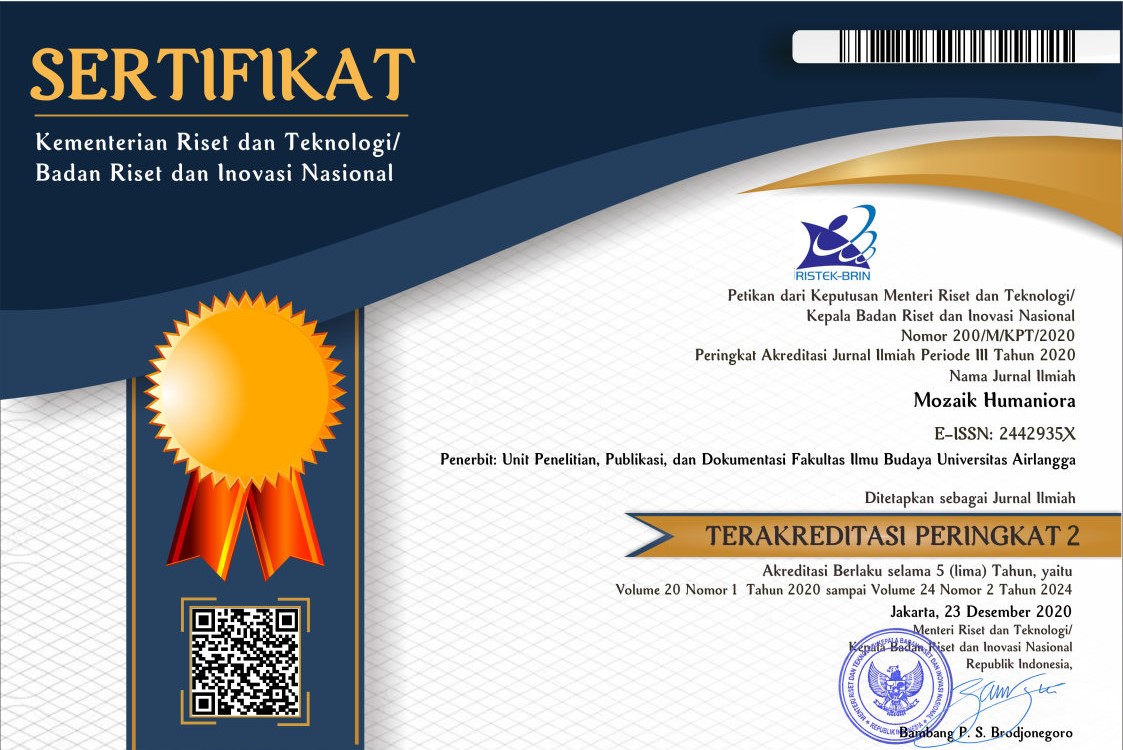Pengaruh Lintas Budaya Tingkat Tutur Hormat Keigo melalui Media Sosial antara Driver Guide dan Wisatawan Jepang di Bali
Downloads
Berita Resmi Statistik Perkembangan and Pariwisata. 2019. "Perkembangan Pariwisata Bali Februari 2019.”
Brown, Penelope dan Stephen C. Levinson. 1978. "Universals in Language Usage: Politeness Phenomena.” Dalam Questions and Politeness: Strategies in Social Interaction, Cambridge University Press.
Budiarta, I. Wayan dan I. Gusti Ngurah Adi Rajistha. 2018. "Politeness in ‘Adit Dan Sopo Jarwo' Animation.” Lingua Cultura 12 (1):25, doi:10.21512/lc.v12i1.1822.
Febriyanti, Rike. 2018. "Strategi Kesopanan Berbahasa Jepang dalam Korespondensi Surat Elektronik Bisnis Sesuai yang Disarankan oleh Penutur Asli Bahasa Jepang.” Erudio Journal of Educational Innovation 5.
Haugh, Michael. 2004. "Revisiting the Conceptualisation of Politeness in English and Japanese.” Multilingua 23 (1/2): 85–110, doi:10.1515/mult.2004.009.
Iori, Isao et al. 2001. "Nihongo Bunpou Handbook.” Tokyo: 3A Corporation.
Irma, Ade. 2017. "Sebagai Media Komunikasi Pemasaran Bisnis.” Jurnal Online Klasik 4 (2): 1–12.
Iwata, Yuka dan Miho Okada. 2018. "Teaching Japanese Language in Tourism and Customer Service Skills.” Journal of Global Tourism Research 3 (2).
Kabaya, Hiroshi, Kimu Dongyu, dan Takagi Miyoshi. 2009. Keigo Hyougen Handobukku. Taishukan Japan.
Kaneko Hiroyuki. 2014. Nihongo Keigo Toreningu. 会社アスク出版.
Kaplan, Andreas M. dan Michael Haenlein. "Users of the World, Unite! The Challenges and Opportunities of Social Media.” Business Horizons 53 (1):59–68.
Kluckhohn, Clyde. 1953. "Universal Categories of Culture.” Anthropology Today 276.
Koentjaraningrat. 2009. Pengantar Ilmu Antropologi. Rineka Cipta.
Kurniawan, Puguh. 2017. "Pemanfaatan Media Sosial Instagram sebagai Komunikasi Pemasaran Modern Pada Batik Burneh." 11:217–25.
Leiliyanti, Eva et al. 2018. "Transcoding Wacana Konstruksi dan Kontestasi Citra Jokowi dan Prabowo dalam Media Sosial pada Masa Kampanye Pilpres 2014.” Mozaik Humaniora 17 (2):192–213.
Mathieson, Alister dan Geoffrey Wall. 1982. Tourism, Economic, Physical and Social Impacts. Longman.
Patrick, Nkemdilim. 2015. "Assessment of Patterns of Readership of Online Newspapers in Selected Nigerian Universities.” International Journal of Linguistics and Communication 3 (2): 35–46, doi:10.15640/ijlc.v3n2a4.
Pizziconi, Barbara. 2004. "Japanese Politeness in the Work of Fujio Minami.” Linguistics 13:269–280.
Purnomo, Budi. 2010. "Politeness Strategies and Levels in Tourism-Service Language in Surakarta Residency.” REGISTER, Language & Language Teaching Journals 3 (1): 153–89.
Rahayu, Ely Triasih. 2014. "Comparison of Honorific Language in Javanese and Japanese Speech Community” International Journal on Studies in English Language and Literature (IJSELL) 2 (7):140–46.
________. "Comparison of Honorific Language in Javanese and Japanese Speech Community.” International Journal on Studies in English Language and Literature, vol. 2, no. 7, 2014, pp. 140–46.
________. 2013. "The Japanese Keigo Verbal Marker.” Advances in Language and Literary Studies 4 (2):104–11, doi:10.7575/aiac.alls.v.4n.2p.104.
Rapp, Adam et al. 2013. "Understanding Social Media Effects Across Seller, Retailer, and Consumer Interactions.” Journal of the Academy of Marketing Science 41 (5):547–566.
Resmi, Berita, et al. 2019. Perkembangan Pariwisata Bali Februari 2019.
Santosa, Riyadi. 2017. Metodologi Penelitian Kualitatif Kebahasaan, disunting oleh Dwi Purnanto. Surakarta: UNS Press.
Sartini, Ni Wayan. 2017. "Strategi Kesantunan Berbahasa Diaspora Orang Bali di Jawa Timur dalam Situasi Formal.” Mozaik Humaniora 16 (2):233–46.
Setiadi, Ahmad. "Pemanfaatan Media Sosial Untuk Efektifitas Komunikasi.” Cakrawala: Jurnal Humaniora Bina Sarana Informatika, vol. 16, no. 2, 2016, pp. 110–116.
Spradley, James P. et al. 1997. Metode Etnografi. Tiara Wacana.
Supratman, Lucy Pujasari. 2018. "Penggunaan Media Sosial oleh Digital Native.” Jurnal Ilmu Komunikasi 15 (1):47–60.
Suryani, Ita. 2014. "Pemanfaatan Media Sosial sebagai Media Pemasaran Produk dan Potensi Indonesia dalam Upaya Mendukung ASEAN Community 2015 (Studi Social Media Marketing Pada Twitter Kemenparekraf RI dan Facebook Disparbud Provinsi Jawa Barat).” Jurnal Komunikasi 8 (2):123-38.
TVRI Pusat Jakarta. 2019. Beryadnya Berbasis Tri Hita Karana. TVRI Pusat Jakarta.
Utami, Agustin Dyah dan Bambang E. Purnama. 2012. "Pemanfaatan Jejaring Sosial sebagai Media Bisnis Online (Studi Kasus di Batik Solo 85).” Seruni FTI UNSA 1: 1-7.
Wahyuningtias, Hani. 2014. "Kajian Kesantunan dalam E-Mail Permohonan yang Ditulis oleh Penutur Jepang dan Pembelajar Indonesia.” Lingua Cultura 8:1-7.
Wiyatasari, Reny. 2017. "Representasi Konsep Uchi-Soto dalam Bahasa Jepang.” Kiryoku Volume 1 (4):37-47.

Mozaik Humaniora is licensed under a Creative Commons Attribution-ShareAlike 4.0 International License. Both authors and Mozaik Humaniora agree with the following attribution of journal:
1. Copyright of this journal is possession of Author, by the knowledge of the Editorial Board and Journal Manager, while the moral right of the publication belongs to the author.
2. The journal allows the author(s) to retain publishing rights without restrictions
3. The legal formal aspect of journal publication accessibility refers to Creative Commons Attribution Share-Alike (CC BY-SA).
4. The Creative Commons Attribution Share-Alike (CC BY-SA) license allows re-distribution and re-use of a licensed work on the conditions that the creator is appropriately credited and that any derivative work is made available under "the same, similar or a compatible license”. Other than the conditions mentioned above, the editorial board is not responsible for copyright violation.


















